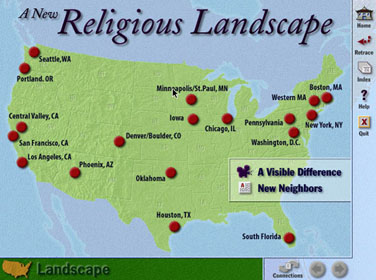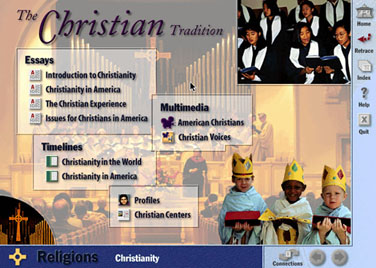
ISSN: 1094-902X
Volume 2, Number 1 (Fall 1998)
On Common Ground: World Religions in America. Diana L. Eck and the
Pluralism Project at Harvard University. Columbia University Press, 1997. CD-Rom
(Windows/Macintosh). $195. [Images © President and Fellows of Harvard College
and Diana L. Eck 1997.]
Diana L. Eck and a team of Harvard student researchers began work on the Pluralism
Project in 1991, collecting information on the religious traditions and institutions that
have become more prominent on the American religious landscape since the changes brought
about by the immigration act of 1965. With the new diversity of immigrants since 1965 has
come enormous religious diversity yet to be taken seriously by most scholars of religion
in America, with a number of significant exceptions. Eck, a scholar of religion in India,
was moved to take up the project by the increasing number of first-generation Indian
Americans in her classes at Harvard, some having grown up as Hindus, Muslims, Sikhs, Jains
across America, and others with no ties to the religious traditions of their grandparents.
(1) On Common Ground: World Religions in
America, a multi-platform CD-ROM, is one of a number of products of their important
work.
 On
Common Ground is a wonderful tool to help scholars, students, teachers, and the
general public understand the histories, beliefs, and practices of fifteen religious
traditions – Afro-Caribbean, Baha’i, Confucian, Buddhist, Christian, Hindu,
Pagan, Jain, Shinto, Taoist, Jewish, Sikh, Zoroastrian, Muslim, and Native Peoples’
– and their impact on the United States. The CD-ROM is divided into three
sections that guide users through the sheer diversity of religions and their many
locations (in A New Religious Landscape), historical information on each tradition
(in America’s Many Religions), and questions and case studies about the impact
of religious diversity on particular communities, on schools, courts, and hospitals, for
example (in Encountering Religious Diversity). Making good use of the possibilities
of multimedia formats, the CD-ROM contains a variety of clickable maps, photographs,
documents, directories and profiles of religious centers, and QuickTime "movies"
with voices and images from interviews with religious leaders and members of various
communities. Users can navigate through material on the CD-ROM by clicking on buttons (as
shown in this screen capture of the interface) or by using pull-down menus. In addition,
the menu feature allows users to create a file of bookmarks for easy reference and return
to frequently-used screens. And, as an ongoing endeavor, the Pluralism Project website contains an
updated, searchable Directory of Religious Centers, an Image Base for use in the
classroom, links to sites with additional information about the religious traditions
included in the CD-ROM, and materials from courses on religious pluralism and world
religions in Boston that Eck teaches at Harvard. It would have been especially exciting if
the publisher had made it possible to integrate new information from the website into the
CD-ROM interface by downloading updates to the user’s computer.
On
Common Ground is a wonderful tool to help scholars, students, teachers, and the
general public understand the histories, beliefs, and practices of fifteen religious
traditions – Afro-Caribbean, Baha’i, Confucian, Buddhist, Christian, Hindu,
Pagan, Jain, Shinto, Taoist, Jewish, Sikh, Zoroastrian, Muslim, and Native Peoples’
– and their impact on the United States. The CD-ROM is divided into three
sections that guide users through the sheer diversity of religions and their many
locations (in A New Religious Landscape), historical information on each tradition
(in America’s Many Religions), and questions and case studies about the impact
of religious diversity on particular communities, on schools, courts, and hospitals, for
example (in Encountering Religious Diversity). Making good use of the possibilities
of multimedia formats, the CD-ROM contains a variety of clickable maps, photographs,
documents, directories and profiles of religious centers, and QuickTime "movies"
with voices and images from interviews with religious leaders and members of various
communities. Users can navigate through material on the CD-ROM by clicking on buttons (as
shown in this screen capture of the interface) or by using pull-down menus. In addition,
the menu feature allows users to create a file of bookmarks for easy reference and return
to frequently-used screens. And, as an ongoing endeavor, the Pluralism Project website contains an
updated, searchable Directory of Religious Centers, an Image Base for use in the
classroom, links to sites with additional information about the religious traditions
included in the CD-ROM, and materials from courses on religious pluralism and world
religions in Boston that Eck teaches at Harvard. It would have been especially exciting if
the publisher had made it possible to integrate new information from the website into the
CD-ROM interface by downloading updates to the user’s computer.
The section of the CD-ROM that focuses on Afro-Caribbean religions contains a summary,
written by J. Lorand Matory, of the historical processes through which African-derived
religions of the Caribbean developed and have made their way to the United States.
Particular attention is given to Santerķa, Vodou, religion in Jamaica (including Obeah,
Pukumina, and Ratafari), and Oyotunji Village (a "New World Yoruba" community in
South Carolina). Other sections of the CD-ROM that would be of interest to scholars of
African-American religious history are those on Islam and Baha’i.
 I
have found On Common Ground a valuable resource in my own attempt to understand and
teach about the new shape of religion in America. Feedback from students who have
used it has been positive as well. Nevertheless, a number of issues concerning the
conception and execution of the project and CD-ROM bear mentioning. First, one cannot help
but notice the relative poverty of the section on Afro-Caribbean experiences (as well as
Baha’i, Confucian, Shinto, Taoist, and Zoroastrian) in relation to the other
traditions. On Common Ground’s coverage of Islam and Hinduism, for example,
include essays, historical timelines, multimedia presentations of voices and profiles of
adherents, in addition to a directory of centers. When compared to the rich information
contained in these parts of the CD-ROM, Afro-Caribbean religions appear to have no
historical context, not to merit analytical essays, and with adherents not worthy of
having their voices and perspectives highlighted. It seems impossible that Eck meant to
convey such a message, but neither the CD-ROM itself, nor the accompanying booklet provide
any information about the cause of this disparity. In addition, it seems strange to focus
on Afro-Caribbean traditions without any attention to the traditional religions brought to
the United States by immigrants from African nations.
I
have found On Common Ground a valuable resource in my own attempt to understand and
teach about the new shape of religion in America. Feedback from students who have
used it has been positive as well. Nevertheless, a number of issues concerning the
conception and execution of the project and CD-ROM bear mentioning. First, one cannot help
but notice the relative poverty of the section on Afro-Caribbean experiences (as well as
Baha’i, Confucian, Shinto, Taoist, and Zoroastrian) in relation to the other
traditions. On Common Ground’s coverage of Islam and Hinduism, for example,
include essays, historical timelines, multimedia presentations of voices and profiles of
adherents, in addition to a directory of centers. When compared to the rich information
contained in these parts of the CD-ROM, Afro-Caribbean religions appear to have no
historical context, not to merit analytical essays, and with adherents not worthy of
having their voices and perspectives highlighted. It seems impossible that Eck meant to
convey such a message, but neither the CD-ROM itself, nor the accompanying booklet provide
any information about the cause of this disparity. In addition, it seems strange to focus
on Afro-Caribbean traditions without any attention to the traditional religions brought to
the United States by immigrants from African nations.
Finally, Eck’s choice of the framework of "pluralism" has caused me to
think a great deal about its applicability and value as a way of thinking about how
Americans (U.S.-born and newly-arrived) might best envision the relationship between
national identity and religious diversity. David A. Hollinger has argued that a pluralist
vision always privileges those groups "that are well established at whatever time the
ideal of pluralism is invoked." (2) Thus,
pluralism provides room for and tolerates newcomers, but does not allow for change in the
fundamental conception of American identity, as in Hollinger’s example of
"cosmopolitanism." Given what is at stake in choosing one approach over the
other it would have been especially useful if Eck had made explicit the reasons for
designing the project around the pluralist model.
Judith Weisenfeld, Barnard College
© 1998 The North Star. All Rights Reserved
Notes:
1. Diana L. Eck, "The Mosque Next Door: Neighboring Faiths," Harvard
Magazine (September-October 1996): 38-44. [return to text]
2. David A. Hollinger, "Postethnic America," Contention,
Volume 2, No. 1 (Fall 1992): 83. [return to text]

